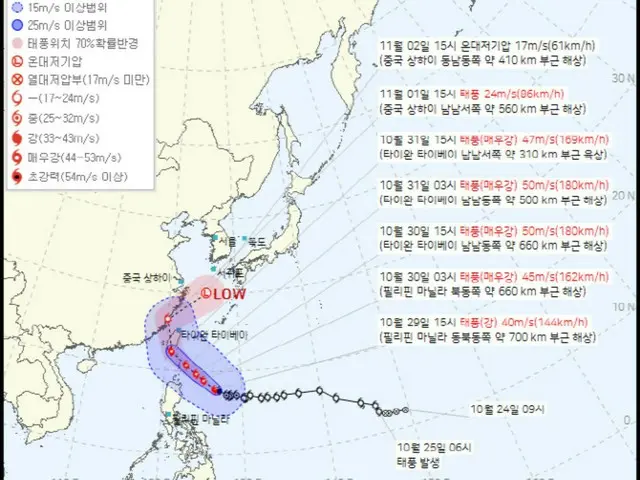According to the Korea Meteorological Administration on the 29th, Typhoon No. 21, which occurred on the 25th, is currently located approximately east-northeast of Manila in the Philippines.
It is moving west-northwest at about 700 km offshore with a maximum wind speed of 40 m and a central pressure of 955 hPa (hectopascals). Typhoon No. 21 is becoming even stronger and is moving north toward the Korean Peninsula.
Typhoons have been predicted to hit the Korean Peninsula, raising the possibility of it hitting the Korean Peninsula. Typhoons have mainly hit the Korean Peninsula between July and October, but if Typhoon 21 hits the Korean Peninsula, the compilation of related statistical data will begin on the 19th.
This will be the first "November typhoon" in 73 years since 1951. The typhoon is expected to approach the sea about 460 km south-southeast of Taipei, Taiwan, on the 31st, with the maximum wind speed at its center increasing to 50 m/s.
Wind speeds of 50 meters are strong enough to fly large stones and derail trains. Typhoon No. 21, which is approaching Taiwan, is weakening and passing over the seas of southeastern China, changing direction to the right, and moving south of Kyushu.
It is expected to move. At this point, experts predict that it will likely become a tropical depression, making it highly unlikely that it will have a direct impact on the Korean Peninsula.
The possibility of Typhoon No. 21 making landfall on the Korean Peninsula has decreased, but as a low pressure system approaches the Korean Peninsula, it is possible that it will bring rain and wind damage to South Korea.
A Meteorological Agency official said, "We ask that people actively take note of the weather information that will be released in the future."
2024/10/29 21:24 KST
Copyrights(C) Edaily wowkorea.jp 78

